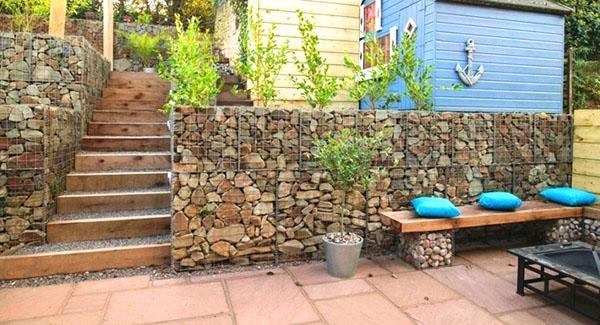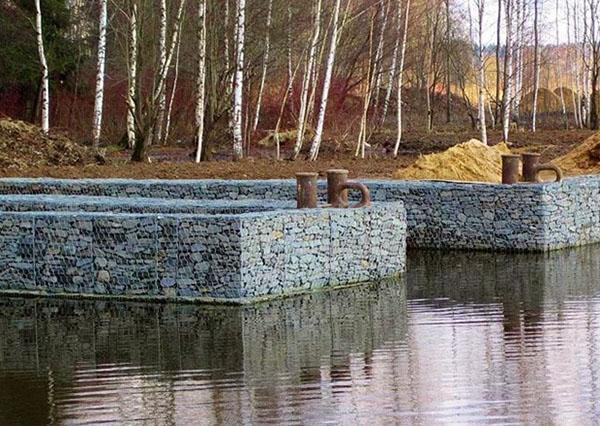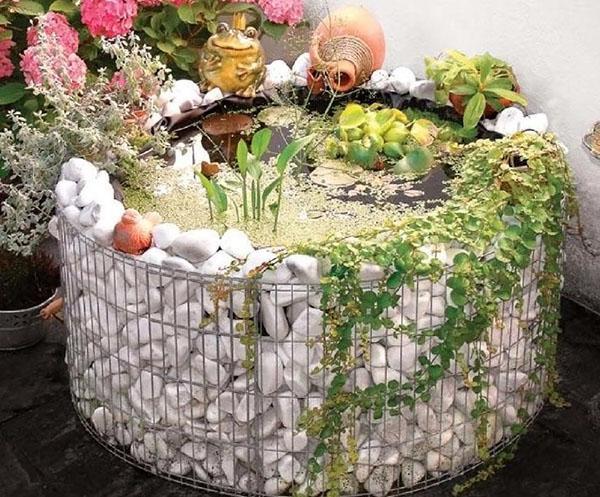How and when can you use gabions on your personal plot
 Gabions are multifunctional and versatile designs. They are containers made of strong wire or strong metal mesh, filled with stone, rubble or other materials. The word "gabion" itself has a foreign origin. Translated from the Italian language "gabbione" means "big cage".
Gabions are multifunctional and versatile designs. They are containers made of strong wire or strong metal mesh, filled with stone, rubble or other materials. The word "gabion" itself has a foreign origin. Translated from the Italian language "gabbione" means "big cage".
Initially, the frames of the gabions were wicker and looked like baskets without a bottom. They were used, starting from the 16th century, in military affairs for the construction of fortifications. From the end of the 19th century, these pre-fabricated structures began to be used in construction. The construction of dams, bridges and retaining walls could not do without them; the strengthening of slopes, slopes and bank protection with gabions were widely used.
Read also:DIY laminate flooring - step by step instructions with a photo
Varieties of gabions and their scope
 Later, wicker baskets were replaced by metal frames, and the structures themselves received new functions. Today gabions are used not only in construction, but also in landscape design... Thanks to the use of various fillers, they can fulfill both their direct purpose, for example, strengthening the coast with gabions, and a decorative function, or combine both of these tasks.
Later, wicker baskets were replaced by metal frames, and the structures themselves received new functions. Today gabions are used not only in construction, but also in landscape design... Thanks to the use of various fillers, they can fulfill both their direct purpose, for example, strengthening the coast with gabions, and a decorative function, or combine both of these tasks.
For the frame of gabions, a strong galvanized wire with a diameter of 2-6 mm is usually used. Individual items are fastened together into a single structure. At the same time, in order to ensure the stability of the structure, to prevent its deformation and premature destruction, the same strong wire is used for the installation of gabions. By the shape of the frame, these products are divided into:
- flat;
- cylindrical;
- box gabions.
 In large structures, dividing partitions (diaphragms) must be provided. At the same time, box-shaped structures can be either mesh or welded gabions, depending on the method of their production.
In large structures, dividing partitions (diaphragms) must be provided. At the same time, box-shaped structures can be either mesh or welded gabions, depending on the method of their production.
Flat gabions, the thickness of which does not exceed 30 cm, are an excellent option for strengthening the banks of streams and rivers, ravine slopes, and laying on the bottom of shallow water bodies.
Having flexibility, these products of small thickness follow all the curves of the surface and any unevenness of the relief.  Such gabions as in the photo can also be laid as a foundation for box structures.
Such gabions as in the photo can also be laid as a foundation for box structures.
Gabions - the choice of specialists
 It is not by chance that these structures attract the attention of builders, owners of personal plots and landscape designers. They have a number of advantages, which should be discussed in more detail:
It is not by chance that these structures attract the attention of builders, owners of personal plots and landscape designers. They have a number of advantages, which should be discussed in more detail:
- The gabion mesh is flexible, which allows the structure to take the shape of any surface. He is not afraid of ground movements: due to its flexibility, the structure can deform, but its destruction will not occur.

- Stone-filled gabions have good moisture permeability. Due to this, the structure will not experience additional hydrostatic loading and will not require a drainage system to drain water.

- Installation of gabions saves time, money, resources and reduces labor costs in comparison with the construction of reinforced concrete structures.
- The structures have strength and stability, which can only increase over time.This is due to the ingress of soil between the fragments of the filler and the germination of plant roots in it.

- Except for the implementation of large-scale projects for the strengthening and reconstruction of coastlines and slopes with gabions, such work does not require the involvement of heavy construction equipment.

- Gabion structures are durable. This quality is due to the properties of natural stone and the strength of galvanized wire. The service life of these structures is calculated in decades. Moreover, their appearance remains practically unchanged.

- The use of gabions in relief areas allows preserving the natural landscape and minimizing human interference in the environment.

- Well-made gabions do not require repair and do not require maintenance throughout the entire period of operation.
These designs are safe and blend in perfectly with the surrounding landscape.
How to make gabions on your own plot on your own
In suburban and suburban areas, gabions can be used for:
- creating and strengthening terraces;
- arrangement of beds, flower beds and flower beds;

- zoning the space of the personal plot;
- creation of small architectural forms;

- strengthening the bottom and banks of decorative reservoirs;

- construction of retaining walls and slope reinforcement;
- construction of decorative fences and borders;

- making the base of garden furniture (benches, chairs, tables);

- erection of fences, both from gabions, and in combination with wooden sections;

- constructions of garden sculptures, figures and other elements of landscape design.
To build gabions on the site, you can invite qualified construction specialists. However, it is quite possible to assemble such a structure on your own, you just need to use high-quality materials. Here is a step-by-step instruction on how to make gabions with your own hands. There are two options:
- Purchase a frame of industrial production, choosing a structure of the required size and in the required quantity. They can be used both for reinforcing slopes with gabions and for decorative purposes. Manufacturers now offer ready-made mesh containers in a wide variety of shapes and sizes. The structures should be installed in the designated place and filled with the selected material.

- Make a frame for a gabion with your own hands, made of wire, a metal rod or mesh, and then, as described above, install it in the chosen place. After that, the most creative part of the work begins: filling the structure. Using imagination and creative inclinations, you can turn the gabion into a real decoration of the site, which will be difficult to pass by without paying attention to it.

For the construction of gabions, you will need a strong metal mesh, special metal spirals, steel pins, staples made of strong wire, braces, geotextile (for bulk materials), filler.  To connect the parts of the box, brackets and metal spirals are used, and with the help of pins, the structure is firmly attached to the ground. The middle of the container can be filled with fine filler (geotextile is used for this), and the front walls with larger stones.
To connect the parts of the box, brackets and metal spirals are used, and with the help of pins, the structure is firmly attached to the ground. The middle of the container can be filled with fine filler (geotextile is used for this), and the front walls with larger stones.
The filler fractions should be larger in size than the cells of the gabion container. The larger the cells, the larger the filler pieces are required.
When arranging surface structures, the size of the filler fractions should be one third larger than the size of the cells of the box or mesh. If the product is intended for operation under water, such a structure should be filled with an even larger stone, it should be one and a half times the size of the cells of the metal container.
Installation of gabions
Filler for gabions: which one to choose?
 If on your site these structures perform the function of retaining walls, reinforcing slopes, or you decide to build a fence from gabions, you must use a strong filler for these purposes. Hard rocks of natural stones are perfect: basalt, quartzite, granite.
If on your site these structures perform the function of retaining walls, reinforcing slopes, or you decide to build a fence from gabions, you must use a strong filler for these purposes. Hard rocks of natural stones are perfect: basalt, quartzite, granite.
You can also use other varieties that are frost-resistant, durable, waterproof, and resistant to temperature extremes. The stone for gabions can be of different shapes and sizes, depending on the size of the cells of the metal frame.  It can be rounded boulders, "wild stone", large pebbles or crushed rubble - any of these materials will not only be durable, but also make the whole structure attractive, make it pleasing to the eye.
It can be rounded boulders, "wild stone", large pebbles or crushed rubble - any of these materials will not only be durable, but also make the whole structure attractive, make it pleasing to the eye.
To fill gabions that perform a decorative function, use materials with an interesting texture or their various combinations.
As a decorative filler for the device of gabions, you can use all kinds of materials, selecting them in accordance with the design style of the site and the color palette.  These can be pieces of glass, cuttings from pipes and metal structures, broken tiles, paving stones, fractions of bricks, tree cuts, thick pieces of bark and other natural or man-made materials.
These can be pieces of glass, cuttings from pipes and metal structures, broken tiles, paving stones, fractions of bricks, tree cuts, thick pieces of bark and other natural or man-made materials.
Video instruction for assembling a gabion structure
Decorative gabions in landscape design
 Today, gabions are increasingly seen in landscape design as decorative elements. There is no doubt that the decorative use of these structures has breathed new life into them. This area allows the use of products, which previously carried exclusively functional loads, as one of the main decorations of the site. And for the embodiment of the fantasies of the designer, this area really provides unlimited scope.
Today, gabions are increasingly seen in landscape design as decorative elements. There is no doubt that the decorative use of these structures has breathed new life into them. This area allows the use of products, which previously carried exclusively functional loads, as one of the main decorations of the site. And for the embodiment of the fantasies of the designer, this area really provides unlimited scope.
 The decorative role of these structures can be successfully combined with their functional purpose. Today, hand-made gabion walls can be seen not only in personal plots as fences, retaining walls, partitions for zoning and in the exterior of buildings, but also in the interior.
The decorative role of these structures can be successfully combined with their functional purpose. Today, hand-made gabion walls can be seen not only in personal plots as fences, retaining walls, partitions for zoning and in the exterior of buildings, but also in the interior.
The illumination of decorative gabions on the site in the evening looks beautiful. Therefore, when erecting these structures, it is worth taking care of their illumination.
 Gabions will be the best solution for the device of the zone B-B-Q and gazebos, facing the banks of small decorative ponds and the construction of fountains, fencing flower beds, making bases for garden furniture and stands for garden sculptures.
Gabions will be the best solution for the device of the zone B-B-Q and gazebos, facing the banks of small decorative ponds and the construction of fountains, fencing flower beds, making bases for garden furniture and stands for garden sculptures.  The fillers of these structures are harmoniously combined with forged parts, natural wood, metal and other materials.
The fillers of these structures are harmoniously combined with forged parts, natural wood, metal and other materials.
Gabions look great on a high-tech or minimalist plot. The asceticism of these structures is perfectly set off by the green lawn, flowering plants and ornamental shrubs. In areas with relief differences, an interesting solution would be to create terraces from gabion structures. The recreation area can be separated with a gabion screen, equipping a cozy corner with an original design.
When constructing an "outdoor" fireplace or gabion barbecue area, special attention should be paid to its filler. It is better if it is a refractory material: stone or brick. A tree will not work for these purposes.
 Gabions in landscape design, the photos of which are given below, surprise with the variety of materials used, shapes, colors.
Gabions in landscape design, the photos of which are given below, surprise with the variety of materials used, shapes, colors.  Thanks to these structures, any plot can acquire a unique look and turn into a comfortable place for recreation, where it is pleasant to gather with the whole family and receive guests.
Thanks to these structures, any plot can acquire a unique look and turn into a comfortable place for recreation, where it is pleasant to gather with the whole family and receive guests.